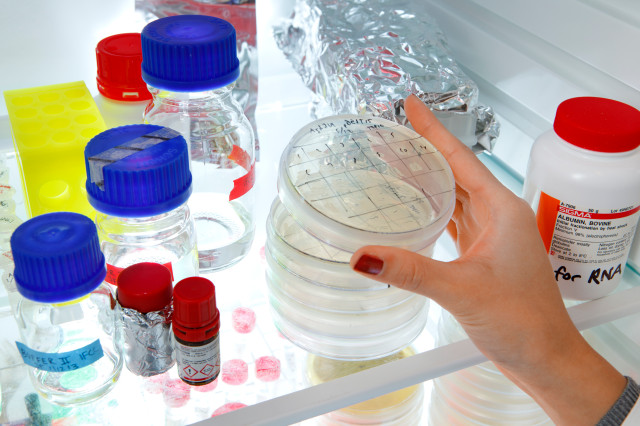Biomolecular structures. High resolution structure detemination techniques such as NMR-spectroscopy and X-ray crystallography. Forces that fold the proteins and maintain the structures. Structure-function relationship examples e.g. transcription factors, immunoglobulines, and signal transduction proteins. Structural databases, visualization and analysis of structures. Applications in pharmaceutical industry.
BB2160 Structure Biology 7.5 credits
This course has been discontinued.
Decision to discontinue this course:
No information inserted
Information per course offering
Course offerings are missing for current or upcoming semesters.
Course syllabus as PDF
Please note: all information from the Course syllabus is available on this page in an accessible format.
Course syllabus BB2160 (Spring 2016–)Content and learning outcomes
Course contents
Intended learning outcomes
Overall goal
The main goal is to provide the student with basic knowledge and insight about the three-dimensional (3D) structure of macromolecules (protein and nucleic acids) and the relationship between structure and function. A general introduction to the determination of 3D structure is included. The teaching is based on a knowledge-interaction concept that is used to increase and deepen the perception and understanding of 3D structure and structure-function relationships. To achieve this, lectures are intimately coupled to interactive computer exercises known as kinetic images (kinemages) where structures are studied and analyzed in 3D.
Specific aims
You should be able to describe the main characteristics of amino acids and the principle types of motifs and folds. You should know about the principle forces that fold the proteins and maintain the structures, and be able to suggest changes to a protein structure that would lead to for instance increased thermostability. You should be able to describe the function of a number of important proteins and relate their function to the structure. With the aid of kinemage exercises, you should be able to draw connections between the information from the course literature and the actual 3D structures. You should know about the functions and tools available in the structure database, and be able to use these for retrieving information and structures, as well as validating structures. You should be able to validate a 3D structure using tools available in the structure database and by analyzing electron-density maps. You should be able to outline the principles for crystallization of soluble, globular proteins. You should know the basic principles for how a 3D structure is determined, most importantly using the method of X-ray crystallography. During the seminar project, you will study, in detail, a specific protein structure and its function. Guided by information retrieved from the course and scientific articles, you should be able to analyze, validate and discuss the structure, and to present your observations and reflections as a written report as well as an oral presentation at the end of the course.
Literature and preparations
Specific prerequisites
Admission requirements for programme students at KTH:At least 150 credits from grades 1, 2 and 3 of which at least 100 credits from years 1 and 2, and bachelor's work must be completed, within a programme that includes:
a minimum of 20 credits within the fields of Mathematics, Numerical Analysis and Computer Sciences, 5 of these must be within the fields of Numerical Analysis and Computer Sciences, 30 credits of Chemistry, possibly including courses in Chemical Measuring Techniques and 20 credits of Biotechnology or Molecular Biology.
Admission requirements for independent students:
A total of 20 university credits (hp) in biochemistry, microbiology and gene technology/molecular biology. 30 university credits (hp) chemistry, as well as 20 university credits (hp) in mathematics and computer science or corresponding. Documented proficiency in English corresponding to English B.
Literature
Branden C. and Tooze J., Introduction to Protein Structure, 2nd Ed. Garland Publishing Inc., 1999, och utdelande handouts.
Examination and completion
Grading scale
Examination
- LIT1 - Literature Task, 2.0 credits, grading scale: P, F
- TEN1 - Written exam, 4.0 credits, grading scale: A, B, C, D, E, FX, F
- LAB1 - Laboratory Work, 1.5 credits, grading scale: P, F
Based on recommendation from KTH’s coordinator for disabilities, the examiner will decide how to adapt an examination for students with documented disability.
The examiner may apply another examination format when re-examining individual students.
If the course is discontinued, students may request to be examined during the following two academic years.
Other requirements for final grade
Examination (TEN 1; 4,0 credits, grading scale A - F), Laboratory Course (LAB1; 1,5 credits, grading scale Pass/Fail)
Literature assignment (LIT1; 2,0 credits, grading scale A-F).
Examiner
Ethical approach
- All members of a group are responsible for the group's work.
- In any assessment, every student shall honestly disclose any help received and sources used.
- In an oral assessment, every student shall be able to present and answer questions about the entire assignment and solution.
Further information
Course room in Canvas
Offered by
Main field of study
Education cycle
Supplementary information
Students are required to sign up at least two weeks in advance for examination.
The course is given provided at least seven students are admitted.